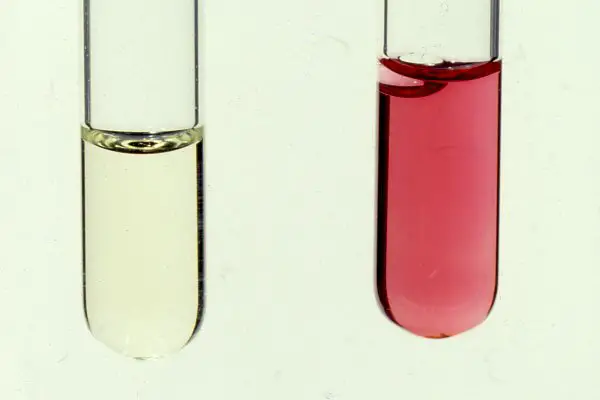VP test is one of the microbiological tests for the identification of bacteria that produce 2,3-Butanediol.
In 1898, Voges and Proskauer, a German bacteriologist, first noted the production of red color in the cultures grown in specific media after adding potassium hydroxide.
But later, Harden revealed that the red color was due to the resultant formation of acetyl methyl carbinol (acetoin).
In 1936 there was further improvement to the test by Barrit. The test’s sensitivity is enhanced by adding alpha-naphthol to the medium before the addition of potassium hydroxide.
Principal and mechanism of VP test
Voges-Proskauer test relies on the digestion of glucose to acetyl methyl carbinol (acetoin).

Some organisms undertake the butylene glycol pathway in the fermentation of glucose.
The chief end product of fermentation is 2-3 butylene glycol (it is a neutral product) besides smaller quantities of mixed acids.
However, the VP test detects the intermediate product, Acetoin.
Due to oxygen in the air and 40% KOH (strong base) in the medium, acetyl methyl carbinol is converted (oxidized) to diacetyl.
This diacetyl reacts with guanidine compounds commonly found in the glucose phosphate peptone medium of the broth. α- naphthol serves as a color intensifier.
- A positive result is indicated by a pink-red color.
- A negative result is indicated by yellow-brown color.
Another principle proving Methyl Red test can be performed along with VP test
All members of the Enterobacteriaceae can convert glucose to pyruvic acid by the Embden-Meyerhof pathway, but bacteria can further metabolize pyruvic acid by two different pathways.
- Organisms that metabolize pyruvic acid by the mixed acid pathway, will produce more acid end products, like lactic acid and acetic acid. These end products maintain an acidic environment.
- If the organism produces many organic acids like formic acid, acetic acid, lactic acid, and succinic acid from glucose fermentation, then the broth medium will remain red after adding methyl red (Methyl red is a pH indicator).
However, MR-negative organisms further metabolize the initial fermentation products by decarboxylation to produce neutral acetyl methylcarbinol (acetoin).
This results in decreased acidity in the medium and becomes the pH towards neutrality (pH 6.0 or above).
MR and the VP test are performed simultaneously because they are physiologically related and are performed on MRVP broth [Methyl Red (MR) and Voges-Proskauer (VP) broth].
Requirement
The test requires two sets of reagents as
Voges – Proskauer reagent A
- 50 gm Alpha naphthol
- 1000 ml of Absolute ethanol
Voges –Proskauer reagent B
- 400 gm Potassium Hydroxide
- 1000 ml Deionized water
- Glucose phosphate peptone water
Procedure for Voges Proskauer test
- As the first step, label the medium tube and Inoculate the microorganisms being tested using a sterile technique.
- The sterile condition could be maintained by working between the bunsen burner.
- Incubate the culture at 37 degrees Celsius for 24 to 48 hours.
- After 24 hours, Allow the inoculated media to settle to room temperature.
- Sterilize the inoculating wire loop by placing it in the blue flame of the Bunsen burner till it gets red.
- Expose the base of the wire first and move towards the tip. Allow it to cool.
- Decap the test tube containing the sample and expose the neck of the tube to the flame to avoid contamination.
- Take the loopful of microorganisms and inoculate the medium(sterile glucose phosphate peptone water) for 24 hours.
- Incubate at temperature 37-degree celsius for 24 hours of time.
- After 24 hours, make an aliquot of 2ml of broth to a clean test tube, maintaining aseptic condition.
- The remaining broth is re-incubated for another 24 hours at 37 degree celsius.
- Add a few drops (6-7 drops) of 5% alpha Naphthol and mix well to aerate.
- Add 1-2 drops of 40% KOH and mix well to aerate.
- Observe for pink-red color within 30 min.
Shake the tubes vigorously during the 30 mins of the period. Shaking the tubes enhances the VP reaction.

Interpretation of Voges Proskauer test results
Positive Reaction
Pink or red color at the surface of the broth
Positive results are seen for
- Streptococci species (except for streptococcus vestibularis),
- Klebsiella aerogen,
- Vibroeltor, Enterobacter,
- Serratiamarcescens,
- Hafniaalvei,
- Vibrio alginolyticus, etc.
Negative Reaction
No color change or yellow-brown color.
Negative results are seen for
- E-Coli
- Shigella
- Salmonella
- Citrobacter species
- Streptococcus mitis
- Yersinia
- Edwardsiella
- Vibrio parahaemolyticus.
A rust color indicates a weak positive reaction.
The VP test should be read within one hour of the addition of reagents.
Because the KOH could react with α-naphthol to form a copper-like color, causing a potential false-positive interpretation.

Quality Control of Voges–Proskauer (VP) Test
- Positive control:- E. aerogenes(ATCC13048)
- Negative control:- E. coli(ATCC25922)
Applications
- It is used to differentiate the Enterobacteriaceae.
This VP test is performed along with other biochemical tests to differentiate the genus and species within the Enterobacteriaceae.
- It is one of the four tests of the IMViC series which tests for evidence of an enteric bacterium.
- It is also used to detect acetoin in broth culture.
It is use to detect organisms like Klebsiella, Listeria, Enterobacter, Vibrio eltor, Hafniaalvei, etc.
What compound does the voges proskauer test specifically detect
VP test specifically detects Acetoin formed in the reaction